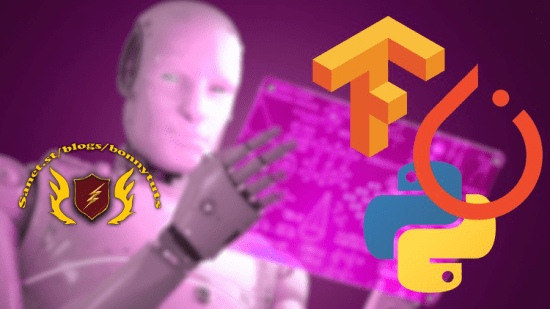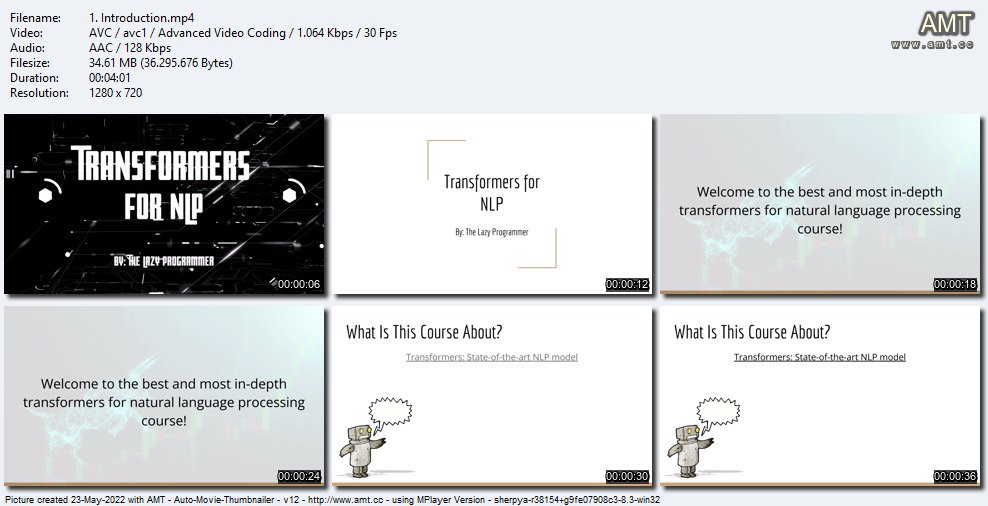
Published 05/2022
MP4 | Video: h264, 1280×720 | Audio: AAC, 44.1 KHz, 2 Ch
Genre: eLearning | Language: English + srt | Duration: 74 lectures (9h 43m) | Size: 3.16 GB
BERT, GPT, Deep Learning, Machine Learning, & NLP with Hugging Face, Attention in Python, Tensorflow, PyTorch, & Keras
What you’ll learn
Apply transformers to real-world tasks with just a few lines of code
Fine-tune transformers on your own datasets with transfer learning
Sentiment analysis, spam detection, text classification
NER (named entity recognition), parts-of-speech tagging
Build your own article spinner for SEO
Generate believable human-like text
Neural machine translation and text summarization
Question-answering (e.g. SQuAD)
Zero-shot classification
Understand self-attention and in-depth theory behind transformers
Implement transformers from scratch
Use transformers with both Tensorflow and PyTorch
Understand BERT, GPT, GPT-2, and GPT-3, and where to apply them
Understand encoder, decoder, and seq2seq architectures
Master the Hugging Face Python library
Requirements
Install Python, it’s free!
Beginner and intermediate level content: Decent Python programming skills
Expert level content: Good understanding of CNNs and RNNs and ability to code in PyTorch or Tensorflow
Description
Hello friends!
Welcome to Data Science: Transformers for Natural Language Processing.
Ever since Transformers arrived on the scene, deep learning hasn’t been the same.
Machine learning is able to generate text essentially indistinguishable from that created by humans
We’ve reached new state-of-the-art performance in many NLP tasks, such as machine translation, question-answering, entailment, named entity recognition, and more
We’ve created multi-modal (text and image) models that can generate amazing art using only a text prompt
We’ve solved a longstanding problem in molecular biology known as “protein structure prediction”
In this course, you will learn very practical skills for applying transformers, and if you want, detailed theory behind how transformers and attention work.
This is different from most other resources, which only cover the former.
The course is split into 3 major parts
Using Transformers
Fine-Tuning Transformers
Transformers In-Depth
PART 1: Using Transformers
In this section, you will learn how to use transformers which were trained for you. This costs millions of dollars to do, so it’s not something you want to try by yourself!
We’ll see how these prebuilt models can already be used for a wide array of tasks, including
text classification (e.g. spam detection, sentiment analysis, document categorization)
named entity recognition
text summarization
machine translation
question-answering
generating (believable) text
masked language modeling (article spinning)
zero-shot classification
This is already very practical.
If you need to do sentiment analysis, document categorization, entity recognition, translation, summarization, etc. on documents at your workplace or for your clients – you already have the most powerful state-of-the-art models at your fingertips with very few lines of code.
One of the most amazing applications is “zero-shot classification”, where you will observe that a pretrained model can categorize your documents, even without any training at all.
PART 2: Fine-Tuning Transformers
In this section, you will learn how to improve the performance of transformers on your own custom datasets. By using “transfer learning”, you can leverage the millions of dollars of training that have already gone into making transformers work very well.
You’ll see that you can fine-tune a transformer with relatively little work (and little cost).
We’ll cover how to fine-tune transformers for the most practical tasks in the real-world, like text classification (sentiment analysis, spam detection), entity recognition, and machine translation.
PART 3: Transformers In-Depth
In this section, you will learn how transformers really work. The previous sections are nice, but a little too nice. Libraries are OK for people who just want to get the job done, but they don’t work if you want to do anything new or interesting.
Let’s be clear: this is very practical.
How practical, you might ask?
Well, this is where the big bucks are.
Those who have a deep understanding of these models and can do things no one has ever done before are in a position to command higher salaries and prestigious titles. Machine learning is a competitive field, and a deep understanding of how things work can be the edge you need to come out on top.
We’ll also look at how to implement transformers from scratch.
As the great Richard Feynman once said, “what I cannot create, I do not understand”.
SUGGESTED PREREQUISITES
Decent Python coding skills
Deep learning with CNNs and RNNs useful but not required
Deep learning with Seq2Seq models useful but not required
For the in-depth section: understanding the theory behind CNNs, RNNs, and seq2seq is very useful
UPDATES TO LOOK FORWARD TO
More fine-tuning applications
More in-depth conceptual lectures
Transformers implemented from scratch
Thank you for reading and I hope to see you soon!
Who this course is for
Anyone who wants to master natural language processing (NLP)
Anyone who loves deep learning and wants to learn about the most powerful neural network (transformers)
Anyone who wants to go beyond typical beginner-only courses on Udemy

Password/解压密码www.tbtos.com
转载请注明:0daytown » Data Science: Transformers for Natural Language Processing